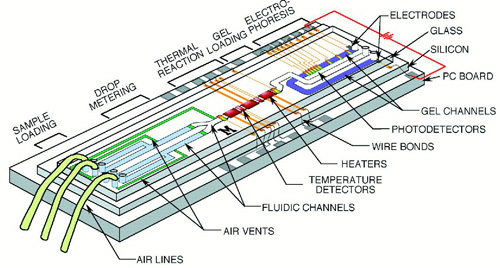Contact:
Diego Barrettino, Senior Scientist, EPFL-IC-LSI
Partners:
Institut Suisse de Recherche Expérimentale sur le Cancer (ISREC), Epalinges, Switzerland.
Keywords:
Automation, biological cells, microfluidics, biomechatronics, single cell analysis
Presentation:
The development of tiny laboratories, commonly called labs-on-a-chip or micro-TAS (Total Analysis Systems), has received a great deal of attention in recent years [1]-[3] (See figure). Small devices that handle sampling, reagent introduction, and analysis can reduce reagent metering and protocol errors, reduce sample and reagent usage, and prevent contamination of the sample or infection of the user. Recently, devices that integrate sample preparation, PCR, DNA hybridization, and electrochemical detection were shown using a palm-sized device requiring only an electrical interface [4]. Glucose, lactate, and oxygen in blood were measured electrochemically within a single device as a step towards a wearable point-of-care monitor [5].

Lab-on-a-chip example from [3]
The next generation of devices will see the integration of components that take advantage of the small scale and are not limited by ties to the macroscopic world. These devices will allow for unprecedented automation and parallel processing of experiments for basic biological research.
Cancer is caused by mutations in the genome that lead to unrestrained cell growth and colonization of other tissue by the resulting tumor. Unfortunately, progress in cancer research is limited by experiments that cannot be carried out because they would take a biologist’s lifetime.
Goal:
The goal of this research line is to explore lab-on-a-chip platforms that could be used for automating and accelerating different experiments for fundamental cancer research.
Publications:
[1] Erickson, D., and Li, D.Q. “Integrated microfluidic devices,” Analytica Chimica Acta 507: 11-26, 2004.
[2] Vilkner, T., Janasek, D., and Manz, A. “Micro total analysis systems. Recent developments,” Analytical Chemistry 76: 3373-3385, 2004.
[3] Burns, M.A. et al. “An Integrated Nanoliter DNA Analysis Device,” Science 282: 484-487, 1998.
[4] Liu, R.H., Yang, J.N., Lenigk, R., Bonanno, J., and Grodzinski, P. “Self-contained, fully integrated biochip for sample preparation, polymerase chain reaction amplification, and DNA microarray detection,” Analytical Chemistry 76: 1824-1831, 2004.
[5] Ahn, C.H., Choi, J.W., Beaucage, G., Nevin, J.H., Lee, J.B., Puntambekar, A., and Lee, J.Y. “Disposable Smart lab on a chip for point-of-care clinical diagnostics,” Proceedings of the IEEE 92: 154-173, 2004.